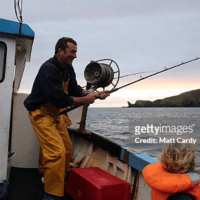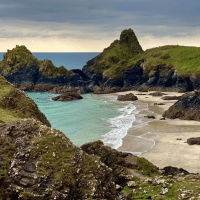
By
Editor
Updated on
The Lizard Peninsula is a coastal gem nestled on the most southerly point of mainland Britain. Known for its breathtaking natural beauty and rich history, this region offers an array of activities and attractions.
Start your exploration at the serene Housel Bay Beach, where sandy shores meet the Atlantic Ocean. Nearby, enjoy a culinary treat at Kynance Cove Cafe with its stunning backdrop of jagged rocks at Kynance Cove.
Or, you can visit the iconic Lizard Lighthouse and embark on scenic adventures along the bustling South-West Coast Path or the peaceful and sheltered East Coast.
Moreover, foodies can indulge their taste buds at Fat Apples Cafe. Not to forget, Roskilly’s Ice Cream Farm offers delightful locally-made ice cream.
With sandy beaches, hidden coves, quaint villages, and a wealth of history, this region’s outstanding natural beauty awaits your discovery. Join us as we unveil the top attractions that make the Lizard Peninsula truly special.

Top 10 Activities To Do On The Lizard Peninsula
1. Soak In Nature’s Bounty In Gardens Galore
Cornwall is renowned for its title as the warmest part of the United Kingdom, although this isn’t always synonymous with the best weather. Along the south coast, you’ll find areas with subtropical microclimates, and the Lizard Peninsula is no exception. This, coupled with its stunning coastal vistas, makes it a hub for some of the country’s most exceptional and distinctive gardens.
Among the famous gardens in this region, Glendurgan and Trebah stand out. Nestled in valleys that lead to the picturesque Helford River, these two share similarities. Abundant with subtropical plants, mature trees, woodland paths, and a beach at the end, choosing between them is a delightful dilemma.
Trebah may slightly tip the scales for avid gardeners, offering a spectacular view beyond iconic palm trees. Meanwhile, Glendurgan beckons explorers with a captivating laurel maze dating back to 1833, not to mention the charming Durgan beach and village nearby. Whichever you opt for (or both), satisfaction is guaranteed.
The Lizard Peninsula is also home to Bonython Estate Gardens, a hidden gem spanning 13 acres around an 18th-century manor house. This estate features lakes, woodlands, and a variety of thoughtfully designed gardens, making it a haven for gardening enthusiasts. Over the last two decades, the current owners have enriched the traditional layout with innovative planting, establishing it as one of Cornwall’s most captivating garden destinations.

2. Explore Kynance Cove And Other Hidden Coves
Plenty has already been said about the marvels of Kynance Cove, with its crystal-clear turquoise waters and awe-inspiring rock formations. The image above speaks volumes, allowing us to shift our focus to other hidden treasures along the Lizard Peninsula’s coastline.
In general, the Lizard Peninsula reveals a sheltered east coastline and an exposed western one, enduring the Atlantic Ocean’s force much like the north coast. The local geology significantly shapes the beaches, especially towards the southern tip, where rocky outcrops abound.
Among these natural wonders, the standouts include the sandy shores of Gunwalloe, Poldhu, and Polurrian on the west coast and Kennack Sands and Coverack on the east.

3. Try Scuba Diving
The waters surrounding the Lizard Peninsula offer some of Cornwall’s clearest, making it an excellent destination for diving. Whether you’re a snorkeler or an experienced open-water SCUBA diver, the rich sea life in these Cornish waters is truly captivating.
Visibility typically extends up to about 30 metres on a good day and half that on average. The seabed here, from shallow reefs to dramatic drop-offs, provides outstanding dive sites.
Notably, the infamous Manacles reef, just off St Keverne, is renowned for its towering pinnacles rising 80 metres from the seabed. Concealed just beneath the surface, these pinnacles have been the site of over 100 shipwrecks over the years, including the passenger liner SS Mohegan, which tragically sank in 1898, leaving its remnants scattered across the reef.
Beyond wreck diving, the waters abound with marine life, from sea fans and lobsters to cuckoo wrasse and elusive conger eels nestled in crevices. Summertime diving may even bring sightings of the world’s second-largest fish, the immense basking shark, on its migratory route through these seas.
Numerous dive centres operate from the Lizard Peninsula, offering diving excursions and courses to explore these underwater wonders.

4. Try Fishing In Cadgwith
Nestled on the eastern coast of the Lizard Peninsula, between Lizard Point and Coverack, lies the picturesque fishing village of Cadgwith.
With origins dating back to mediaeval times, it began as a cluster of fish cellars nestled in a sheltered coastal valley, boasting a shingle cove and excellent protection from the prevailing south-westerly gales. Fishing has remained a vital aspect of Cadgwith’s identity throughout its history, as evidenced by the small fleet of boats still gracing its shores today.
Cadgwith, inhabited since the 16th century, boasts numerous original local stone and thatch houses, a rarity in Cornwall. These charming residences cling to the steep valley sides, with all roads leading to the village’s cherished harbour.
Cadgwith boasts two beaches, separated by a small headland known as ‘The Todden’ during high tide. Deep-sea diving expeditions to offshore wrecks like The Craggan and The Boa are popular, as is the historic Cadgwith Cove Inn, believed to be over four centuries old.

5. Visit Historical Sites
Much like the rest of Cornwall, the Lizard Peninsula boasts a rich historical tapestry. However, its fascinating history diverges due to its unique geology. While the Lizard Peninsula experienced the prosperous pilchard fishing era, it missed out on the tin and copper mining that transformed Cornwall into a global industrial hub.
In the 1800s, the Lizard briefly flirted with mining when serpentine, a rare rock found miles beneath the Earth’s surface, gained popularity. The Lizard Serpentine Company (L.S.C.) established five quarries and a stone-cutting factory at Carleon Cove, leaving remnants still visible today.
Ancient sites pepper the Lizard Peninsula, including the enigmatic Dry Tree Menhir and the imposing Halliggye Fogou, an underground passage on the Trelowarren Estate believed to date back to the Iron Age.
The Lizard’s modern history stands out prominently in the realm of communications. Poldhu, on the western tip, witnessed the transmission of the first transatlantic radio signal, marking the dawn of the radio age. The wooden hut used in the experiment still exists under National Trust ownership.
The Lizard’s pioneering role in telecommunications continued with the Goonhilly Satellite Earth Station, once the world’s largest. Its iconic, colossal dishes, visible for miles, played a vital role in satellite communication. While Goonhilly ceased operations in 2006, discussions about repurposing the dishes for space exploration continue, embodying the Lizard’s ever-evolving historical significance.

6. Dig Into An Ice Cream Sundae In Roskilly’s Farm
Located on the eastern side of the Lizard Peninsula, not far from Coverack and St Keverne, lies Roskilly’s, a fully operational dairy farm spanning 40 acres. This farm is home to a herd of over 100 Jersey cows, and visitors are welcome to witness the daily milking sessions, with the 4:30 p.m. session proving more popular than the early 5 a.m. one.
The farm also hosts various other animals, including pigs, goats, sheep, and chickens. Visitors can even feed most of these animals, and feed bags are readily available at the shop adjacent to the restaurant.
However, Roskilly’s isn’t solely famous for its cows and organic milk production; it’s renowned for its diverse ice cream offerings, featuring over 30 unique flavours, including unusual ones like sour cherry, marzipan, and Hokey Pokey. For the ultimate indulgence, try their gargantuan sundaes.
Beyond ice cream, Roskilly’s offers a comprehensive menu, with summer dining in a charming leafy courtyard. If you wish to walk off your culinary delights, you can explore the farm’s ponds, meadows, orchards, and the Old Withy Woods.
For those seeking breakfast alternatives, Fat Apples Cafe near Porthallow is a quirky gem with excellent breakfast options. Meanwhile, on the opposite side of the Lizard, the Halzephron Inn is renowned for serving some of Cornwall’s finest pub grub.

7. Visit Coverack
Nestled behind Chynalls Point, on a relatively sheltered stretch of the Cornish coast, lies the enchanting village of Coverack. Despite its remote setting, it’s one of the Lizard Peninsula’s most beloved destinations. With a sizable, partially sandy beach and a picturesque harbour lined with whitewashed cottages, Coverack embodies the quintessential Cornish village charm.
Coverack’s origins date back to the thriving pilchard industry that once thrived in these waters. While those days are long gone, a few small boats still ply the crystal-clear local waters.
Beyond the beach and harbour, the Paris Hotel stands as a highlight, offering an ideal spot for al fresco dining on summer evenings. The hotel’s name traces back to one of the numerous shipwrecks along this coast, the ocean liner SS Paris, which ran aground on Lowland Point, distinguishing itself from the infamous Manacles Reef wrecks.

8. Travel To The Lizard Point
If it weren’t for Lizard Point’s status as mainland Britain’s southernmost tip, the entire Lizard Peninsula might have a different character. It’s challenging to envision many visitors journeying beyond Helston or Falmouth if not for the pilgrimage to this geographical extreme. However, Lizard Point has been a significant landmark for centuries.
The point has strong maritime connections, serving as the initial sighting point for many vessels approaching from the Atlantic. While it offers a crucial reference, it also signals the perilous waters in the vicinity. Extending beyond Lizard Point are extensive shallow reefs, claiming numerous ships over time. The Lizard Lighthouse, dating back to the 1750s, undoubtedly saved countless lives and now features an intriguing visitor centre.
Lizard Point itself is a dramatic locale with towering rugged cliffs plunging into the Atlantic. Extending seaward, jagged rocks rise above the surface, resembling bared teeth warning passing ships to steer clear. Yet, the cliffs reveal a softer side in spring and summer, adorned with blossoms like hottentot fig, thrift, and samphire. These cliffs also provide excellent opportunities to spot marine life, including seals, dolphins, and the occasional basking shark.

9. Visit Mullion Cove
Mullion Cove, owned by the National Trust, lies half a mile southwest of Mullion village on Cornwall’s east coast. Its solid granite harbour walls, built in 1895, protect against fierce winter storms.
Mullion Island, a volcanic relic, serves as a breeding ground for various seabirds. Cliffs of schist and serpentine envelop the cove.
Exploring the cliffs, you’ll find spring flowers like squill and rare Green-Winged orchids. Keep an eye out for seals and dolphins.
The cliff path offers superb views of the harbour and island. While Mullion Village may seem unremarkable, Mullion Cove and its geological wonders make it a noteworthy destination.

10. Stock Up On Booze At Constantine Stores
Nestled on the northern edge of the picturesque Lizard Peninsula, between the idyllic towns of Helston and Falmouth, lies the unassuming village of Constantine.
Its setting is nothing short of delightful, situated just a leisurely stroll away from the serene creeks of the Helford River and a mere stone’s throw from two renowned local treasures, Trebah and Glendurgan Gardens. However, at first glance, one might be forgiven for overlooking this charming village as just another quaint stop along the way.
Yet, hidden within Constantine’s unpretentious exterior lies a remarkable and wholly unexpected surprise – Constantine Stores, a true TARDIS of spirits. This unassuming village shop conceals one of the most extensive collections of alcoholic beverages in the entire South West region. With a legacy spanning over six decades as a family-run establishment, the shop initially gained recognition for its selection of fine whiskies sourced from across the globe.
Presently, it proudly showcases a staggering array of over a thousand whisky varieties alongside an impressive assortment of artisanal gins, rums, cognacs, Armagnacs, and other exquisite tipples. While it may not fit the conventional image of a souvenir shop, Constantine Stores is an absolute must-visit for anyone seeking a rare find or simply looking to bring back a taste of Cornwall; this hidden gem awaits your discovery.

Conclusion
In conclusion, the Lizard Peninsula offers a rich tapestry of experiences for all, from the tranquillity of coastal paths and woodland walks to the family-friendly shores of Gunwalloe Church Cove.
Explore the historic harbours of Lizard Village and Coverack, where fishing boats bob by the harbour walls, and savour the local flavours in the charming House Inn or the Top House Inn. Don’t forget to indulge in creamy Cornish ice cream parlours, and if you’re lucky, spot the grey seals basking along the shores.
Moreover, discover the region’s unique history at the Marconi Centre and browse the treasures at a typical souvenir shop. From scenic vistas to local delicacies, the Lizard Peninsula invites you to experience authentic Cornish life at its best.
About The Author

Reviewed by
Editor
Related Posts
[wp post shortcode here]

